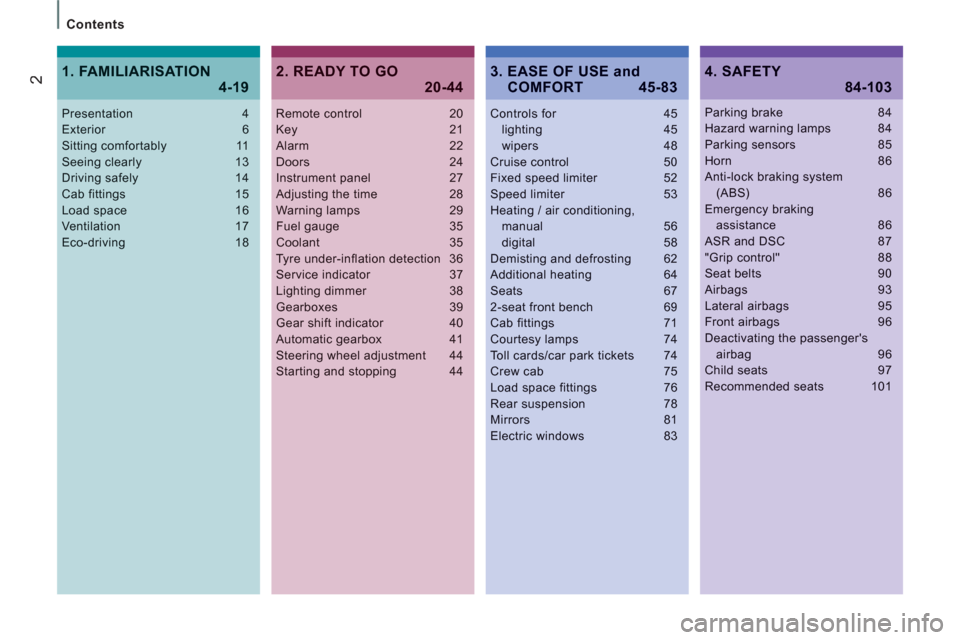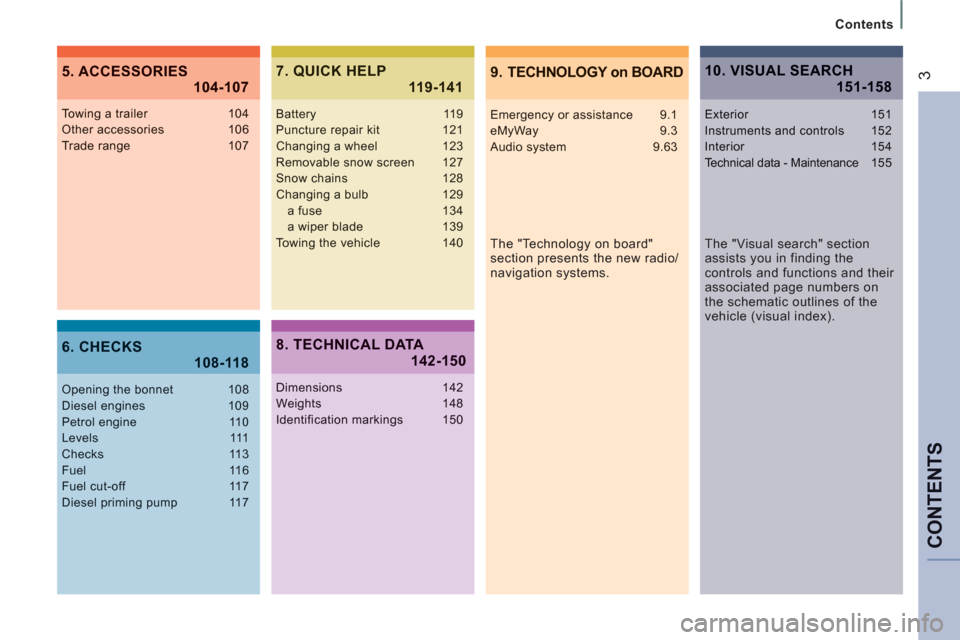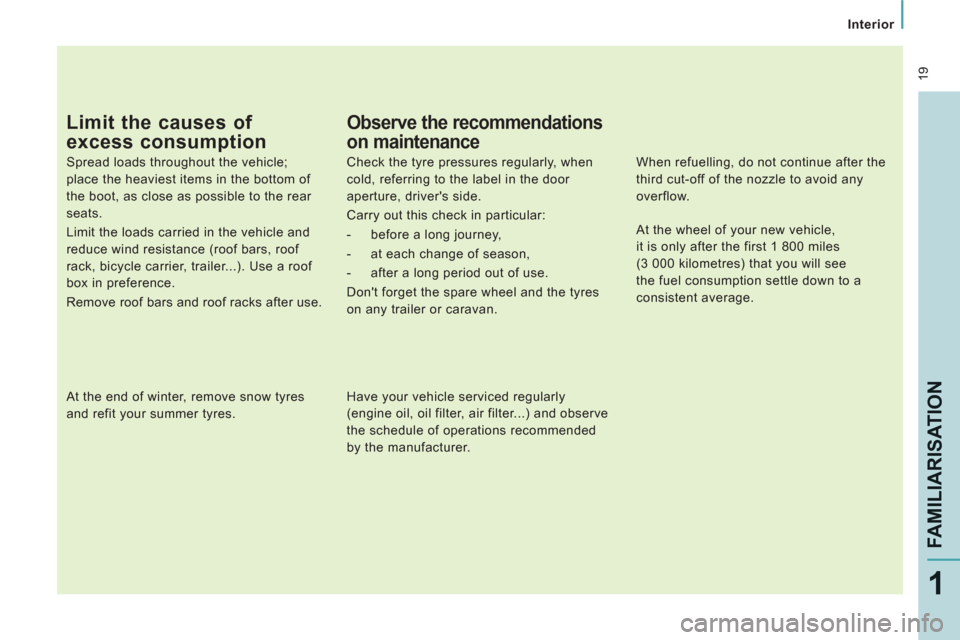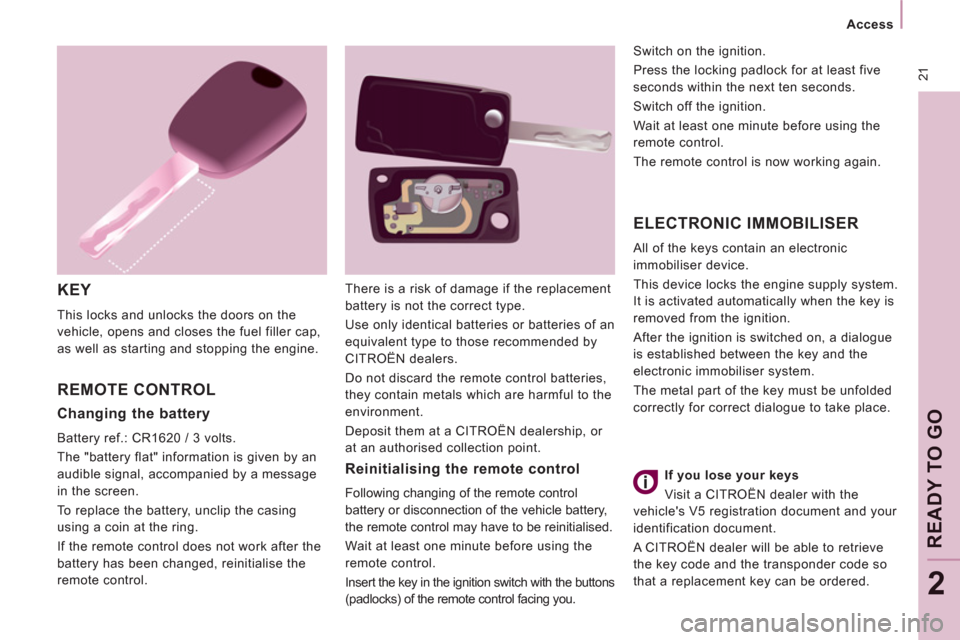fuel Citroen JUMPY 2013 2.G Owner's Manual
[x] Cancel search | Manufacturer: CITROEN, Model Year: 2013, Model line: JUMPY, Model: Citroen JUMPY 2013 2.GPages: 248, PDF Size: 8.07 MB
Page 4 of 248

2
Contents
Remote control 20Key 21Alarm 22Doors 24Instrument panel 27Adjusting the time 28Warning lamps 29Fuel gauge 35Coolant 35Tyre under-inflation detection 36Service indicator 37Lighting dimmer 38Gearboxes 39Gear shift indicator 40Automatic gearbox 41Steering wheel adjustment 44Starting and stopping 44
Controls for 45lighting 45wipers 48Cruise control 50Fixed speed limiter 52Speed limiter 53Heating / air conditioning,manual 56digital 58Demisting and defrosting 62Additional heating 64Seats 672-seat front bench 69Cab fittings 71Courtesy lamps 74Toll cards/car park tickets 74Crew cab 75Load space fittings 76Rear suspension 78Mirrors 81
Electric windows 83
2. READY TO GO
20-44
4. SAFETY
84-103
Presentation 4Exterior 6Sitting comfortably 11Seeing clearly 13Driving safely 14Cab fittings 15Load space 16Ventilation 17Eco-driving 18
1. FAMILIARISATION
4-19
Parking brake 84Hazard warning lamps 84Parking sensors 85Horn 86Anti-lock braking system(ABS) 86Emergency braking assistance 86ASR and DSC 87"Grip control" 88Seat belts 90Airbags 93Lateral airbags 95Front airbags 96Deactivating the passenger'sairbag 96Child seats 97Recommended seats 101
3. EASE OF USE and COMFORT 45-83
Page 5 of 248

CONTENT
S
Contents
39. TECHNOLOGY on BOARD5. ACCESSORIES
104-107
6. CHECKS 108-118
7. QUICK HELP 119-141
The "Technology on board"
section presents the new radio/
navigation systems.
Towing a trailer 104Other accessories 106Trade range 107
Opening the bonnet 108Diesel engines 109Petrol engine 110Levels 111Checks 113Fuel 116Fuel cut-off 117Diesel priming pump 117
Battery 119Puncture repair kit 121Changing a wheel 123Removable snow screen 127Snow chains 128Changing a bulb 129a fuse 134
a wiper blade 139Towing the vehicle 140
8. TECHNICAL DATA142-150
Dimensions 142Weights 148Identification markings 150
10. VISUAL SEARCH 151-158
Emergency or assistance 9.1eMyWay 9.3Audio system 9.63
The "Visual search" section
assists you in finding the
controls and functions and their
associated page numbers on
the schematic outlines of the
vehicle (visual index).
Exterior 151Instruments and controls 152Interior 154Technical data - Maintenance155
Page 20 of 248

Interior
18ECO-DRIVING
Eco-driving is a range of everyday practices that allow the motorist to optimise their fuel
consumption and CO
2 emissions.
Optimise the use of your
gearbox
With a manual gearbox, move off gently,
change up without waiting and drive by
changing up quite soon. If your vehicle has
the system, the gear shift indicator invites
you to change up; it is displayed in the
instrument panel, follow its instructions.
With an automatic or electronic gearbox,
stay in Drive "D"
or Auto "A"
, according to
the type of gearbox, without pressing the
accelerator pedal heavily or suddenly.
Control the use of your
electrical equipment
Before moving off, if the passenger
compartment is too warm, ventilate it by
opening the windows and air vents before
using the air conditioning.
Above 30 mph (50 km/h), close the windows
and leave the air vents open.
Switch off the headlamps and front
foglamps when the level of light does not
require their use.
Avoid running the engine before moving
off, particularly in winter; your vehicle will
warm up much faster while driving.
Drive smoothly
Maintain a safe distance between vehicles,
use engine braking rather than the
brake pedal, and press the accelerator
progressively. These practices contribute
towards a reduction in fuel consumption and
CO
2 emissions and also helps reduce the
background traffic noise.
If your vehicle has cruise control, make use
of the system at speeds above 25 mph
(40 km/h) when the traffic is flowing well.
As a passenger, if you avoid connecting
your multimedia devices (film, music,
video game...), you will contribute towards
limiting the consumption of electrical
energy, and so of fuel.
Disconnect your portable devices before
leaving the vehicle.
Remember to make use of equipment
that can help keep the temperature in the
passenger compartment down (sunroof
and window blinds...).
Switch off the air conditioning, unless it
has automatic digital regulation, as soon
as the desired temperature is attained.
Switch off the demisting and defrosting
controls, if not automatic.
Switch off the heated seat as soon as
possible.
Page 21 of 248

19
Interior
FAMILIARISATIO
N
1
Limit the causes of
excess consumption
Spread loads throughout the vehicle;
place the heaviest items in the bottom of
the boot, as close as possible to the rear
seats.
Limit the loads carried in the vehicle and
reduce wind resistance (roof bars, roof
rack, bicycle carrier, trailer...). Use a roof
box in preference.
Remove roof bars and roof racks after use.
At the end of winter, remove snow tyres
and refit your summer tyres.
Observe the recommendations
on maintenance
Check the tyre pressures regularly, when
cold, referring to the label in the door
aperture, driver's side.
Carry out this check in particular:
- before a long journey,
- at each change of season,
- after a long period out of use.
Don't forget the spare wheel and the tyres
on any trailer or caravan.
Have your vehicle serviced regularly
(engine oil, oil filter, air filter...) and observe
the schedule of operations recommended
by the manufacturer.
When refuelling, do not continue after the
third cut-off of the nozzle to avoid any
overflow.
At the wheel of your new vehicle,
it is only after the first 1 800 miles
(3 000 kilometres) that you will see
the fuel consumption settle down to a
consistent average.
Page 23 of 248

21
Access
READY TO GO
2
KEY
This locks and unlocks the doors on the
vehicle, opens and closes the fuel filler cap,
as well as starting and stopping the engine.
REMOTE CONTROL ELECTRONIC IMMOBILI
SER
All of the keys contain an electronic
immobiliser device.
This device locks the engine supply system.
It is activated automatically when the key is
removed from the ignition.
After the ignition is switched on, a dialogue
is established between the key and the
electronic immobiliser system.
The metal part of the key must be unfolded
correctly for correct dialogue to take place.
Reinitialising the remote control
Following changing of the remote control
battery or disconnection of the vehicle battery,
the remote control may have to be reinitialised.
Wait at least one minute before using the
remote control.
Insert the key in the ignition switch with the buttons
(padlocks) of the remote control facing you. Switch on the ignition.
Press the locking padlock for at least five
seconds within the next ten seconds.
Switch off the ignition.
Wait at least one minute before using the
remote control.
The remote control is now working again.
There is a risk of damage if the replacement
battery is not the correct type.
Use only identical batteries or batteries of an
equivalent type to those recommended by
CITROËN dealers.
Do not discard the remote control batteries,
they contain metals which are harmful to the
environment.
Deposit them at a CITROËN dealership, or
at an authorised collection point.
Changing the battery
Battery ref.: CR1620 / 3 volts.
The "battery flat" information is given by an
audible signal, accompanied by a message
in the screen.
To replace the battery, unclip the casing
using a coin at the ring.
If the remote control does not work after the
battery has been changed, reinitialise the
remote control.
If you lose your keys
Visit a CITROËN dealer with the
vehicle's V5 registration document and your
identification document.
A CITROËN dealer will be able to retrieve
the key code and the transponder code so
that a replacement key can be ordered.
Page 27 of 248

25
Access
READY TO GO
2
SLIDING SIDE DOOR
If fitted on your vehicle, do not open the left-
hand side door while filling with fuel as you
risk damaging the fuel filler flap.
From the outside
Pull the handle towards you then towards
the rear.
Good practice
Take care not to block the guide space on
the floor to allow the door to slide correctly.
For safety and operation reasons, do not
drive with the sliding side door open.
From the inside
To unlock and open, push the handle
towards the rear. Ensure that the door opens
fully to lock the device at the base of the
door.
Operation in the event of a battery
failure
Front and side passenger doors
In the event of a battery or of the central
locking fault, use the lock to lock the doors
mechanically.
- To open the door and get out of the
vehicle, pull the interior control.
- To lock the door, insert the key in the
lock, located on the edge of the door,
then turn it one eighth of a turn
.
Driver's door
- Insert the key in the lock, then turn it to
the right to lock or to the left to unlock.
Page 29 of 248

Instruments and controls
READY TO GO
2
INSTRUMENT PANEL
1.
Distance recorder in miles / kilometres.
2.
Screen.
3.
Fuel level, coolant temperature.
4.
Rev counter.
5.
Instrument panel lighting dimmer.
6.
Trip distance recorder / service indicator
zero reset.
Instrument panel screen
- Speed limiter / cruise control.
- Miles / kilometres travelled.
- Service indicator, engine oil level
indicator, total miles / kilometres.
- Presence of water in the Diesel filter.
- Diesel pre-heating.
- Gear shift indicator.
Warning lamp and controls in the
overhead storage unit
- Passenger's airbag deactivated warning
lamp.
- Driver / passenger heated seat controls
(version with 2 front seats).
INSTRUMENTS AND CONTROLS
Page 33 of 248

31
Instruments and controls
READY TO GO
2
Warning lamp
is
indicates
Solution-action
Front / lateral /
curtain airbag flashing or
remains on. failure of an airbag. Have the system checked by a CITROËN dealer or a
qualified workshop without delay. Chapter 4, "Airbags"
section.
Front
passenger
airbag
deactivated on. intentional deactivation of this
airbag in the presence of a
rearwards facing child seat. Chapter 4, "Airbags-children on board" section.
Low fuel level on with gauge
needle in the red
zone. that when it first comes on
approximately 8 litres
of fuel
remain. It is essential to fill the tank to avoid running out of fuel.
Never continue to drive until you run out of fuel, this
could damage the emissions control and injection
systems.
Tank capacity: approximately 80 litres. remains on each
time the ignition
is switched on. not enough fuel added.
flashing. fuel supply cut off following a
serious impact. Restore the supply. Chapter 6, "Fuel" section.
EOBD emission
control system flashing or
remains on. malfunction of the system. Have the system checked by a CITROËN dealer or a
qualified workshop as soon as possible.
Battery charge on. fault in the charging circuit. Check the battery terminals, … Chapter 7, "Battery"
section.
flashing. placing of the active functions
on standby (economy mode). Chapter 7, "Battery" section.
remaining on,
in spite of the
checks. faulty circuit, injection or
ignition malfunction. Contact a CITROËN dealer or a qualified workshop.
Page 36 of 248

34
Instruments and controls
Screen
is
indicates
Solution-action
Cruise control on. cruise control selected. Manual selection. Chapter 3, "Steering mounted
controls" section.
Speed limiter on. speed limiter selected. Manual selection. Chapter 3, "Steering mounted
controls" section.
Gear shift
indicat
or on. a recommendation that is
independent of the traffic
configuration and density. to reduce fuel consumption, change up on a manual
gearbox.
The driver retains responsibility for following this
indication or not.
Diesel pre-
heating on. climatic conditions requiring
pre-heating. Wait until the warning lamp goes off before operating
the starter.
Particle
emissions filter
on. a malfunction of the particle
emissions filter (Diesel additive
level, risk of clogging, ...). Have the filter checked by a CITROËN dealer or a
qualified workshop.
Chapter 6, "Checks" section.
Presence of
water in the
Diesel filter on and
accompanied by
a message in
the screen. water in the Diesel filter. Have the filter bled by a CITROËN dealer or a qualified
workshop without delay.
Chapter 6, "Checks" section.
Service
spanner on. service due shortly.
Refer to the list of checks in the servicing and warranty
booklet. Have the service carried out by a CITROËN
dealer or a qualified workshop.
Time on. adjustment of the time. Use the left-hand button on the instrument panel.
Chapter 2, at the beginning of the "Instruments and
controls" section.
Page 37 of 248

35
Instruments and controls
READY TO GO
2
FUEL GAUGE
The fuel level is tested each time the key is
turned to the "running" position.
The gauge is positioned on:
- 1:
the fuel tank is full, approximately
80 litres.
- 0:
the reserve is now being used, the
warning lamp comes on continuously.
COOLANT TEMPERATURE
The needle is positioned before the red
zone:
normal operation.
In arduous conditions of use or hot climatic
conditions, the needle may move close to
the red graduations.
What you should do if the warning lamp
comes on:
- stop immediately, switch off the ignition.
The fan may continue to operate for
a certain time, up to approximately
10 minutes,
- wait for the engine to cool down in order
to check the coolant level and top it up if
necessary.
Refer to the "Fuel" section of chapter 6.
What you should do if the needle enters
the red zone:
Reduce your speed or let the engine run at
idle. Refer to the "Levels" section of
chapter 6. The reserve when the warning first comes
on is approximately 8 litres. As the cooling system is pressurised, follow
this advice in order to avoid any risk of
scalding:
- wait at least one hour after switching off
the engine before carrying out any work,
- unscrew the cap by 1/4 turn to allow the
pressure to drop,
- when the pressure has dropped, check
the level on the expansion bottle,
- if necessary, remove the cap to top up.
If the needle remains in the red zone, have
the system checked by a CITROËN dealer
or a qualified workshop.